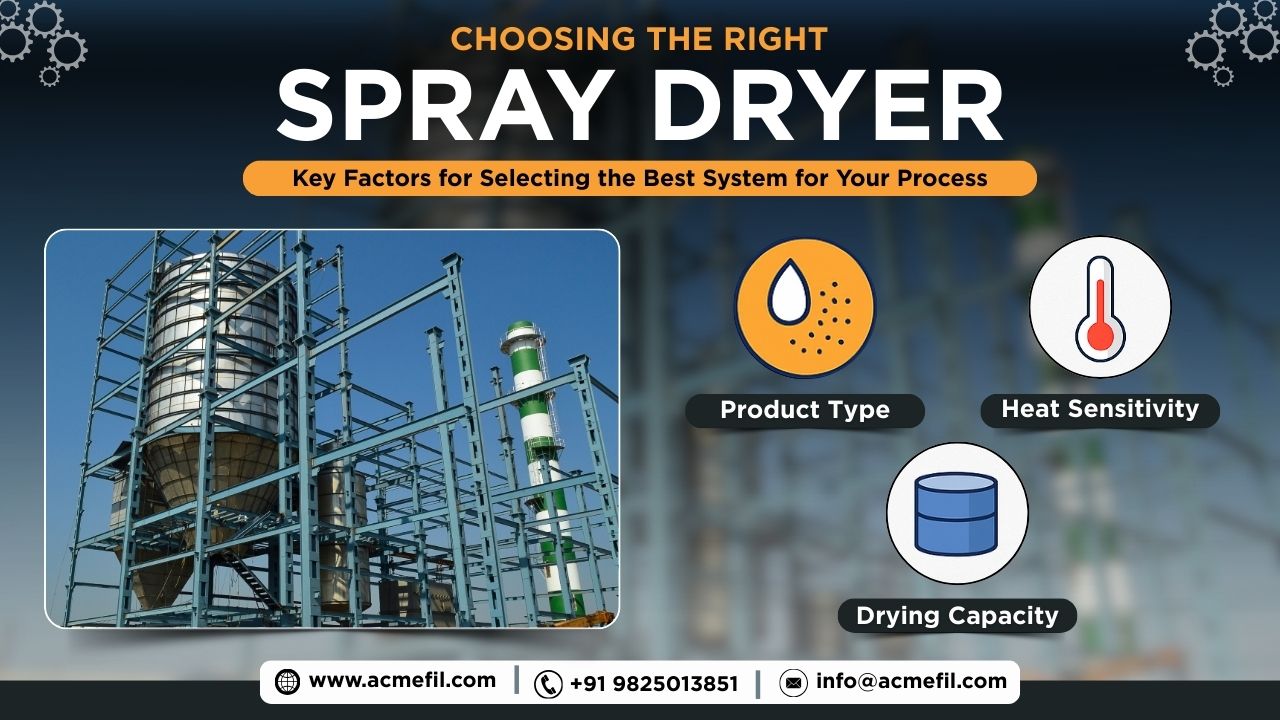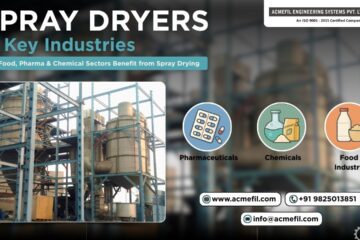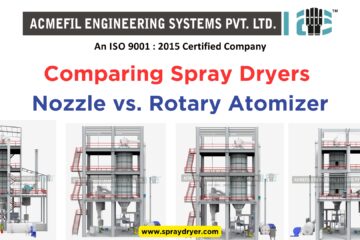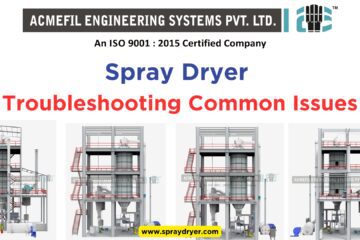Did you know that selecting the wrong spray dryer can increase your operational costs by up to 30% and significantly reduce product quality? With industrial drying technology evolving rapidly, choosing the right spray dryer has become more critical than ever for manufacturers across pharmaceutical, food, chemical, and ceramic industries. This comprehensive guide will walk you through the essential factors to consider when selecting a spray dryer that perfectly matches your production needs and budget constraints.
Table of Contents
What Is a Spray Dryer and Why Is the Selection Process Crucial?
A spray dryer is a specialized piece of equipment that transforms liquid materials into dry powder form through a rapid drying process. The liquid feed is atomized into fine droplets that are exposed to hot gas, causing nearly instantaneous evaporation and resulting in dry particles.
Choosing the right spray dryer isn’t just about purchasing equipment—it’s about making a strategic investment that directly impacts:
- Product quality and consistency
- Operational efficiency and energy consumption
- Production capacity and scalability
- Compliance with regulatory standards
- Long-term operational costs and ROI
Let’s dive into the critical factors you need to consider to make an informed decision.
Key Factors for Choosing the Right Spray Dryer
1. Process Requirements and Material Properties
Feed Material Characteristics
The properties of your feed material significantly influence the spray dryer selection:
- Viscosity: Higher viscosity liquids require more robust atomization systems and may necessitate specialized nozzle designs.
- Solid Content: Feeds with higher solid content typically need more energy for drying and may require pre-concentration.
- Thermal Sensitivity: Heat-sensitive materials (like enzymes or probiotics) demand lower inlet temperatures and shorter residence times.
- Particle Size Requirements: The desired final particle size dictates the atomization method and chamber design.
One production manager from a pharmaceutical company shared: “We initially underestimated the importance of feed viscosity when selecting our spray dryer. This oversight led to frequent nozzle clogging and inconsistent particle sizes, ultimately requiring a costly retrofit.”
Product Specifications
Your end product requirements directly impact spray dryer selection:
- Moisture Content: The required final moisture percentage influences drying parameters.
- Particle Size Distribution: Different applications demand specific particle size ranges.
- Bulk Density: The target density affects drying conditions and atomization methods.
- Flow Properties: Requirements for flowability impact the drying method and conditions.
2. Spray Dryer Configuration Options
Drying Chamber Design
The chamber design affects product characteristics and operational efficiency:
- Co-Current Flow: The feed and drying air flow in the same direction, ideal for heat-sensitive materials.
- Counter-Current Flow: The feed and drying air flow in opposite directions, offering higher thermal efficiency but potentially damaging heat-sensitive products.
- Mixed Flow: Combines both flow patterns for specialized applications.
Atomization Systems
The method of atomization significantly impacts particle properties:
- Rotary Atomizers:
- Produce uniform particles
- Handle higher feed rates
- Less prone to clogging
- Typically require larger chambers
- Pressure Nozzles:
- Lower energy consumption
- Produce coarser particles
- More compact design
- Risk of clogging with high-viscosity feeds
- Two-Fluid Nozzles:
- Better for viscous feeds
- Finer particle size control
- Higher operational costs
- More complex maintenance
Air Heating Systems
Heating systems affect energy efficiency and product quality:
- Direct Heating: Gas combustion products directly contact the product, offering higher energy efficiency but potential contamination risks.
- Indirect Heating: Heat exchangers separate combustion products from drying air, providing cleaner processing but lower thermal efficiency.
- Electric Heating: Offers precise temperature control but typically has higher operational costs.
3. Production Scale and Capacity Requirements
Current and Future Production Needs
Consider both immediate and long-term requirements:
- Batch Size: Determine your typical production volume per batch.
- Continuous Operation: Assess whether continuous processing is necessary.
- Scalability: Evaluate if the equipment can be upgraded to meet future expansion.
- Operating Hours: Calculate expected daily/weekly usage to determine durability needs.
A food processing plant manager advised: “We projected 20% growth over five years and selected a spray dryer with 30% extra capacity. This foresight saved us from a major capital investment just two years later when demand suddenly increased.”
Space and Installation Constraints
Physical limitations impact equipment selection:
- Available Floor Space: Spray dryers have varying footprints and ceiling height requirements.
- Existing Infrastructure: Consider compatibility with current utilities and services.
- Building Access: Ensure the equipment can be transported to the installation site.
- Future Expansion Plans: Allow space for potential additions or modifications.
4. Energy Efficiency and Operational Costs
Energy Consumption Metrics
Energy usage significantly impacts operational expenses:
- Specific Energy Consumption: kWh per kg of water evaporated
- Heat Recovery Systems: Options for recirculating exhaust air
- Thermal Insulation Quality: Impacts heat loss during operation
- Start-up Energy Requirements: Energy needed during system warm-up
Maintenance and Service Requirements
Long-term operational considerations include:
- Cleaning Accessibility: Easy-to-clean systems reduce downtime.
- Replacement Parts Availability: Check the supply chain for critical components.
- Service Support: Evaluate manufacturer’s service network and response times.
- Expected Service Life: Consider the equipment’s projected operational lifespan.
Advanced Technology Features in Modern Spray Dryers
Automation and Control Systems
Modern control features enhance operational efficiency:
- PLC Systems: Programmable logic controllers for precise process management
- HMI Interfaces: User-friendly human-machine interfaces
- Recipe Management: Pre-programmed settings for different products
- Data Logging: Historical performance tracking for quality assurance
Safety and Compliance Features
Critical considerations for regulatory requirements:
- Explosion Protection: ATEX compliance for handling combustible dusts
- CIP (Clean-in-Place) Systems: Automated cleaning for pharmaceutical or food applications
- Containment Solutions: Features for handling toxic or potent compounds
- Validation Documentation: Documentation packages for regulated industries
An engineer from a chemical company noted: “Our initial focus was solely on drying capacity, but we quickly realized that explosion protection and proper containment were critical for our application. The additional investment in safety features prevented potentially catastrophic incidents.”
Industry-Specific Considerations When Choosing the Right Spray Dryer
Pharmaceutical Applications
Special requirements for pharmaceutical manufacturing:
- GMP Compliance: Materials and design must meet Good Manufacturing Practice standards.
- Product Containment: Protection for operators and environment from active ingredients.
- Validation Capabilities: Equipment must support process validation requirements.
- Material Traceability: Documentation of all product-contact materials.
Food and Dairy Industry Requirements
Considerations for food-grade applications:
- Sanitary Design: Materials and construction that meet food safety standards.
- Easy Cleaning: Accessible surfaces and CIP capabilities.
- Flavor Retention: Process parameters that preserve sensory properties.
- Nutritional Preservation: Minimizing thermal degradation of sensitive components.
Chemical Industry Applications
Special needs for chemical processing:
- Corrosion Resistance: Materials compatible with aggressive chemicals.
- Explosion Protection: Robust safety systems for flammable substances.
- Emissions Control: Systems to capture and treat exhaust gases.
- Abrasion Resistance: Durable components for abrasive materials.
How to Evaluate and Compare Spray Dryer Manufacturers
Technical Support and Service Networks
Assess post-purchase support:
- Installation Assistance: Support during setup and commissioning
- Operator Training: Comprehensive training programs
- Troubleshooting Responsiveness: Availability of technical support
- Spare Parts Inventory: Access to critical replacement components
Track Record and References
Evaluate manufacturer credibility:
- Industry Experience: Years of presence in your specific industry
- Customer Testimonials: Feedback from current users
- Case Studies: Documented success stories in similar applications
- Site Visits: Opportunities to see operational installations
A production director shared: “We visited three different facilities using the spray dryer models we were considering. These site visits revealed practical operational challenges that weren’t evident in product brochures and significantly influenced our final decision.”
Economic Analysis for Spray Dryer Selection
Total Cost of Ownership Calculation
Look beyond initial purchase price:
- Capital Investment: Initial equipment and installation costs
- Operating Costs: Energy, labor, and consumables
- Maintenance Expenses: Routine service and repairs
- Downtime Costs: Production losses during maintenance
- Residual Value: Equipment value at the end of its service life
ROI and Payback Period Estimation
Financial evaluation metrics:
- Energy Savings: Compared to older technologies or alternatives
- Product Quality Improvements: Value of enhanced product attributes
- Capacity Increases: Production volume benefits
- Labor Efficiencies: Reduced operator intervention requirements
Common Mistakes to Avoid When Choosing a Spray Dryer
Underestimating Process Complexity
Frequent oversight areas:
- Feed Variability: Not accounting for variations in input materials
- Scale-Up Challenges: Assuming linear scaling from pilot to production
- Integration Requirements: Overlooking connections with upstream/downstream processes
- Regulatory Hurdles: Not anticipating compliance requirements
Insufficient Testing and Validation
Critical pre-purchase steps:
- Pilot Testing: Conducting trials with actual feed materials
- Performance Guarantees: Securing contractual performance assurances
- Reference Checks: Speaking with users of similar installations
- Worst-Case Scenario Planning: Evaluating equipment performance under challenging conditions
Step-by-Step Guide to Selecting the Right Spray Dryer
- Define Your Requirements: Document product specifications, production volumes, and key constraints.
- Research Available Technologies: Investigate suitable spray dryer types and configurations.
- Contact Multiple Suppliers: Request detailed quotations and technical specifications.
- Conduct Material Tests: Arrange for test runs using your actual feed materials.
- Evaluate Test Results: Compare performance data across different options.
- Perform Economic Analysis: Calculate ROI and total cost of ownership.
- Check References: Speak with existing customers about real-world experiences.
- Finalize Specifications: Develop detailed technical requirements.
- Negotiate Terms: Secure performance guarantees and support agreements.
- Plan Implementation: Develop installation, validation, and training schedules.
FAQ: Choosing the Right Spray Dryer
What is the typical lifespan of a well-maintained spray dryer?
A properly maintained spray dryer typically lasts 15-25 years, with critical components like atomizers requiring more frequent replacement. The actual lifespan depends significantly on operating conditions, material properties, and maintenance practices.
How do I determine the right chamber size for my application?
Chamber size depends on several factors including required evaporation rate, product residence time, particle characteristics, and heat sensitivity. Working with experienced equipment manufacturers to conduct pilot tests with your actual materials provides the most reliable sizing information.
Are used or refurbished spray dryers a cost-effective option?
Refurbished spray dryers can offer cost savings of 30-50% compared to new equipment. However, they may lack the latest efficiency and control features. This option works best when purchasing from reputable suppliers who provide thorough reconditioning, testing, and warranties.
How important is pilot testing before purchasing a spray dryer?
Pilot testing is crucial, especially for new products or applications. It verifies achievable product specifications, identifies potential processing challenges, and provides data for accurate equipment sizing. Most manufacturers offer pilot testing services for a fee, which is typically credited toward equipment purchase.
What are the typical energy requirements for spray drying operations?
Energy consumption typically ranges from 1.2-2.5 kWh per kilogram of water evaporated, depending on system design and efficiency. The primary energy demand comes from heating the inlet air, with additional requirements for atomization and air movement systems.
Conclusion
Choosing the right spray dryer involves carefully balancing technical requirements, operational considerations, and economic factors. By methodically evaluating material properties, production needs, and manufacturer capabilities, you can select equipment that delivers optimal performance and value over its entire lifecycle.
Remember that the lowest purchase price rarely represents the best long-term value. Focus instead on total cost of ownership, reliability, product quality consistency, and manufacturer support capabilities to make a truly informed decision.
Whether you’re installing your first spray dryer or upgrading existing equipment, the investment of time in proper selection will pay dividends through improved product quality, reduced operational costs, and enhanced production capabilities for years to come.
About Acmefil Engineering Systems Pvt. Ltd.
When it comes to industrial drying solutions you can trust, Acmefil Engineering Systems Pvt. Ltd. stands as India’s premier choice. Since 1992, our ISO 9001:2015 certified company has designed and manufactured state-of-the-art spray dryers featuring patented atomization technology, customizable configurations, and industry-leading energy efficiency. Our spray dryers deliver precise particle size control, exceptional product uniformity, and seamless integration with existing production lines across pharmaceutical, food, chemical, and ceramic applications. With over 800 successful installations nationwide and comprehensive turnkey solutions from design to commissioning, Acmefil remains committed to maximizing your production efficiency while minimizing operational costs.




